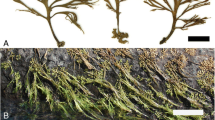Abstract
Calyces of 306 species representing 181 out of the 236 genera of Lamiaceae have been studied with particular emphasis on the amount of fibres and similar xylem cells. A characteristic calyx tissue called ``mesophyll fibres'', reported by earlier authors, is found to belong to the xylem. Most species of the subfamilies Lamioideae and Scutellarioideae differ from most other labiates, and particularly from Nepetoideae, in having much larger amounts of fibres and similar xylem cells in the calyx tube. This result supports cladistic hypotheses based on cpDNA showing that Lamioideae and Scutellarioideae are closely related and remotely related to Nepetoideae. The new data also contribute to the knowledge about the phylogeny within Lamioideae. The amount of fibres and similar cells also seems to be positively correlated with calyx size, calyx width, a ballistic dispersal mechanism in Scutellaria, and the aridity of the habitat. Possible adaptive significances of these correlations are discussed.
Similar content being viewed by others
References
Briquet J. (1893). Monographie du genre Galeopsis. F. Hayez, Bruxelles
Briquet J. (1895–1897) Labiatae. In: Engler A., Prantl K. (eds.) Die natürlichen Pflanzenfamilien 4, 3a W. Engelmann, Leipzig, pp. 183– 375.
El-Gazzar A. and Watson L. (1970). A taxonomic study of Labiatae and related genera. New Phytol. 69: 451–486
Erdtman G. (1945). Pollen morphology and plant taxonomy. IV. Labiatae, Verbenaceae and Avicenniaceae. Svensk Bot. Tidskr. 39: 279–285
Fahn A. (1990). Plant anatomy. 4th ed. Butterworth-Heinemann, Oxford
Harley R. M., Atkins S., Budantsev A. L., Cantino P. D., Conn B. J., Grayer R., Harley M. M., de Kok R., Krestovskaja T., Morales R., Paton A. J., Ryding O. and Upson T. (2004). Labiatae. In: Kubitzki, K. and Kadereit, J. W. (eds) The families and genera of vascular plants 7, pp 167–275. Springer, Berlin
Hillson C. J. (1959). Comparative studies of floral morphology of the Labiatae. Amer. J. Bot. 46: 451–459
Holmgren P. K., Holmgren N. H. and Barnett L. C. (1990). Index herbariorum, part. 1: The herbaria of the world. 8th ed. New York Botanical Garden, New York
Kumari S. D. (1982). Evolution of calyx in Lamiaceae. J. Indian Bot. Soc. 61: 129–137
Lindquist C. and Albert V. A. (2002). Origin of the Hawaiian endemic mints within North American Stachys (Lamiaceae). Amer. J. Bot. 89: 1709–1724
Nordhagen R. (1936). Über dorsiventrale und transversale Tangentballisten. Svensk Bot. Tidskr. 30: 443–473
Paton A. (1992). The adaptive significance of calyx and nutlet morphology in Scutellaria. In: Harley, R. and Reynolds, T. (eds) Advances in labiate science, pp 203–210. Royal Botanic Gardens, Kew
Press J. R. (1982). Taxonomic studies in the Labiatae tribe Pogostemoneae. Bull. Brit. Mus., Bot. 10: 1–89
Ryding O. (1992). The distribution and evolution of myxocarpy in Lamiaceae. In: Harley, R. and Reynolds, T. (eds) Advances in labiate science, pp 85–96. Royal Botanic Gardens, Kew
Ryding O. (1994). Pericarp structure in the tribe Prasieae (Lamiaceae-Lamioideae) and its systematic implications. Bot. Jahrb. Syst. 116: 391–399
Ryding O. (1995). Pericarp structure and phylogeny of the Lamiaceae-Verbenaceae-complex. Pl. Syst. Evol. 198: 101–141
Sebald O. (1980). Die Gattung Leucas R. Brown (Labiatae) in Afrika und auf der Arabischen Halbinsel. Stuttgarter Beiträge zur Naturkunde, Serie A 341: 1–200
Wagstaff S. J., Hickerson L., Spangler R., Reeves P. A. and Olmstead R. G. (1998). Phylogeny in Labiatae s. l., inferred from cpDNA sequences. Pl. Syst. Evol 209: 265–274
Wink M. and Kaufmann M. (1996). Phylogenetic relationships between some members of the subfamily Lamioideae (family Labiatae) inferred from nucleotide sequences of the rbcL gene. Bot. Acta 109: 139–148
Wu C. Y. and Chow S. (1965). Duo taxa nova Labiatarum. Acta Phytotax. Sin. 10: 249–256
Wunderlich R. (1967). Ein Vorschlag zu einer natürlichen Gliederung der Labiaten auf Grund der Pollenkörner, der Samenentwicklung und des reifen Samens. Oester. Bot. Z. 114: 383–483
Author information
Authors and Affiliations
Corresponding author
Rights and permissions
About this article
Cite this article
Ryding, O. Amount of calyx fibres in Lamiaceae, relation to calyx structure, phylogeny and ecology. Plant Syst. Evol. 268, 45–58 (2007). https://doi.org/10.1007/s00606-007-0537-y
Received:
Accepted:
Published:
Issue Date:
DOI: https://doi.org/10.1007/s00606-007-0537-y




